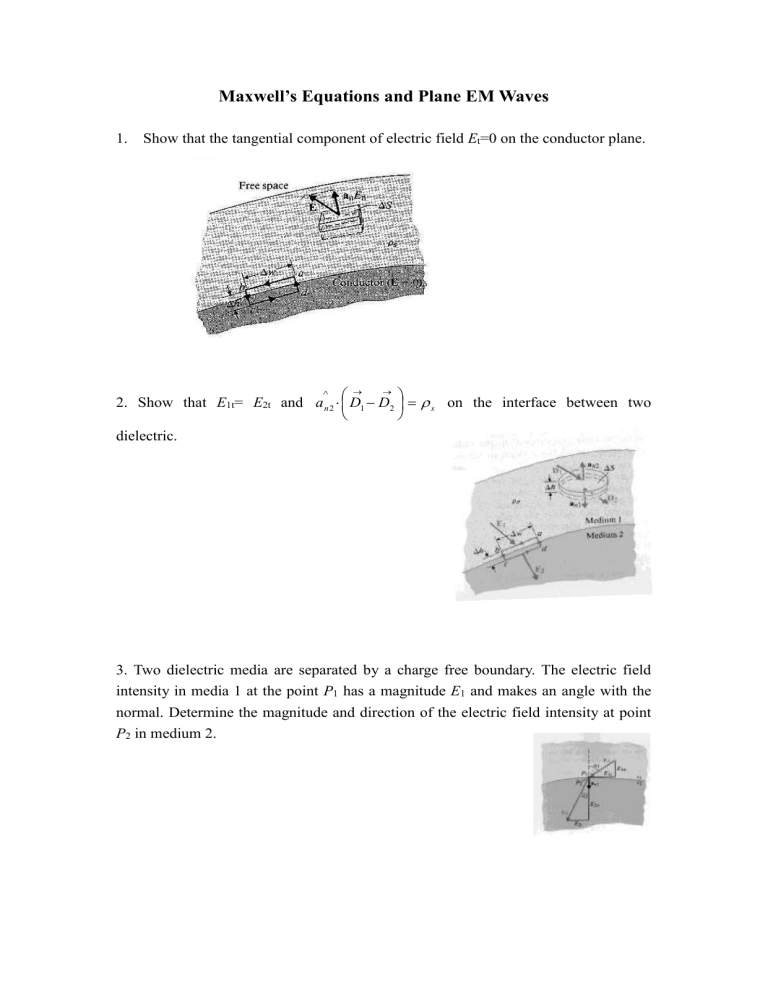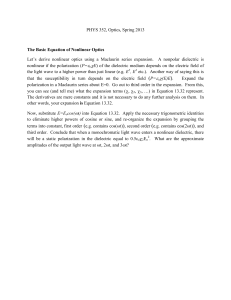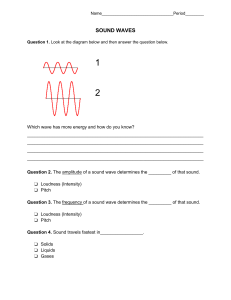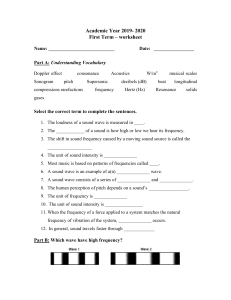
Maxwell’s Equations and Plane EM Waves 1. Show that the tangential component of electric field Et=0 on the conductor plane. 2. Show that E1t= E2t and a n 2 D1 D2 s on the interface between two dielectric. 3. Two dielectric media are separated by a charge free boundary. The electric field intensity in media 1 at the point P1 has a magnitude E1 and makes an angle with the normal. Determine the magnitude and direction of the electric field intensity at point P2 in medium 2. 4. Assume that z=0 plane separates two lossless dielectric regions with εr1=2 and εr2=3. If E1 in region 1 is x 2 y y 3x z 5 z , find E 2 and D2 at z=0 in region 2. 5. A lucite sheet (εr=3.2) is introduced perpendicularly in a uniform electric field E 0 x E 0 in free space. Determine Ei , Di and Pi inside the lucite. 6. Dielectric lenses can be used to collimate electromagnetic fields. The left surface of the lens is that of a circular cylinder, and right surface is a plane. If E1 at point P(r0,45°,z) in region 1 is ar 5 a 3 , what must be the dielectric constant of the lens in order that E 3 in region 3 is parallel to the x-axis? 7. Show that μ1H1n=μ2H2n and aˆ n 2 ( H 1 H 2 ) J . 8. Two magnetic media with permeabilities μ1 and μ2 have a common boundary. The magnetic field intensity in medium 1 at the point P1 has a magnitude H1 and makes an angle α1 with the normal. Determine the magnitude and the direction of the magnetic field intensity at point P2 in medium 2. 9. Consider a plane boundary (y=0) between air (region 1, μr1=1) and iron (region 2, μr2=5000). (a) Assuming B1 0.5 xˆ 10 yˆ (mT), find B 2 and the angle that B2 makes with the interface. (b) Assuming B2 10 xˆ 0.5 yˆ (mT), find B1 and the angle that B1 makes with the normal to the interface. 10. An emf V is applied across a parallel-plate capacitor of area S. The space between the conducting plates is filled with two different lossy dielectrics of thicknesses d1 and d2, permittivities ε1 and ε2, and conductivities σ1 and σ2, respectively. Determine (a) the current density between the plates, (b) the electric field intensities in both dielectrics. 11. Assume a rectangular conducting sheet of conductivity σ, width a, and height b. A potential difference is applied to the side edges. Find (a) the potential distribution, (b) the current density everywhere within the sheet. 12. Lightning strikes a lossy dielectric sphere εr=1.2, σ=10S/m, of radius 0.1m at time t=0, depositing uniformly in the sphere a total charge 1mC. Determine for all t for (a) the electric field intensity both inside and outside the sphere, (b) the current density in the sphere, (c) calculate the time it takes for the charge density in the sphere to diminish to 1% of its initial value, (d) calculate the charge in the electrostatic energy stored in the sphere as the charge density diminished from the initial value to 1% of the value. What happens to this energy? (e) determine the electrostatic energy stored in the space outside the sphere. Does this energy charge with time? ( 13. Two lossy dielectric media with permittivities and conductivities (ε1, σ1) and (ε2, σ2) are in contact. An electric field with a magnitude E 1 is incident from medium 1 upon the interface at an angle α1 and measured from the common normal, as in Figure. (a) Find the magnitude and direction of E 2 in medium 2. (b) Find the surface charge density at the interface. 14. Two conducting media with conductivities σ1 and σ2 are separated by an interface. The steady current density in medium 1 at point P1 has a magnitude J1 and makes an angle α1 with the normal. Determine the magnitude and direction of the current density at point P 2 in Medium 2. 15. A voltage source V0sin(ωt), is connected across a parallel-plate capacitor C. Find the displacement current in the capacitor. 16. A sinusoidal electric intensity of amplitude 250V/m and frequency 1GHz exists in a lossy dielectric medium that has a relative permittivity of 2.5 and loss tangent of 0.001. Find the average power dissipated in the medium per cubic meter. 17. Given that H yˆ 2 cos(15x) sin( 6 10 9 t z ) in air, find E and β. 18. Given that E yˆ 0.1cos(10x) sin( 6 10 9 t z ) in air, find H and β. 19. The electric field intensity of a spherical wave in free space is E E aˆ R 0 sin cos(t kR) . Determine the magnetic field intensity. R 20. The instantaneous expression for the magnetic field intensity of a uniform plane wave propagating in the +y direction in air is given by H zˆ 4 10 6 cos(10 7 t k 0 y ) A/m. (a) Determine k0 and the location where 4 H z vanishes at t=3ms. (b) Write the instantaneous expression for E . 21. A 100MHz uniform plane wave E xˆE x propagates in the +z direction. Suppose εr=4, μr=1, σ=0, and it has a maximum value of 10-4V/m at t =0 and z=0.125m. (a) Write the instantaneous expressions for E and H . (b) Determine the location where E is a positive maximum when t=10-8sec. 22. The E field of a uniform plane wave propagating in a dielectric medium is z z given by E (t , z ) xˆ 2 cos(10 8 t ) yˆ sin( 10 8 t ) V/m. (a) Determine the 3 3 frequency and wavelength of the wave. (b) What is the dielectric constant of the medium? (c) Describe the polarization of the wave. (d) Find the corresponding H field. 23. Write down the instantaneous expression for the electric- and magnetic-field intensities of sinusoidal time-varying uniform plane wave propagating in free space and having the following characteristics: (1) f=10GHz; (2) direction of propagation is the +z direction; (3) left-hand circular polarization; (4) the initial condition is the electric field in the z=0 plane and t=0 having an x-component equal to E0 and a y-component equal to √3E0 24. Show that P( z, t ) of a circularly–polarized plane wave propagating in a lossless medium is a constant. 25. The radiation electric field intensity of an antenna system is E aˆ E aˆ E , find the expression for the average outward power flow per unit area. 26. Find P on the surface of a long, straight conducting wire of radius b and conductivity σ that carries a direct current I. Verify Poynting’s theorem. 27. E (t , z ) xˆ100 cos(10 7 t ) V/m at z=0 in seawater: εr=72, μr=1, σ=4S/m. (a) Determine α, β, vp, and ηc. (b) Find the distance at which the amplitude of E is 1% of its value at z=0. (c) Write E(z,t) and H(z,t) at z=0.8m, suppose it propagates in the +z direction. 28. The magnetic field intensity of a linearly polarized uniform plane wave propagating in the +y direction in seawater εr=80, μr=1, σ=4S/m is H xˆ 0.1sin( 1010 t ) A/m. (a) Determine the attenuation constant, the phase 3 constant, the intrinsic impedance, the phase velocity, the wavelength, and the skin depth. (b) Find the location at which the amplitude of H is 0.01 A/m. (c) Write the expressions for E(y,t) and H(y,t) at y=0.5m as function of t. 29. Given that the skin depth for graphite at 100 MHz is 0.16mm, determine (a) the conductivity of graphite, and (b) the distance that a 1GHz wave travels in graphite such that its field intensity is reduced by 30dB. 30. Determine and compare the intrinsic impedance, attenuation constant, and skin depth of copper σcu=5.8×107S/m, silver σag=6.15×107S/m, and brass σbr=1.59×107S/m at following frequencies: 60Hz and 1GHz. 31. A 3GHz, y-polarized uniform plane wave propagates in the +x direction in a nonmagnetic medium having a dielectric constant 2.5 and a loss tangent 10-2. (a) Determine the distance over which the amplitude of the propagating wave will be cut in half. (b) Determine the intrinsic impedance, the wavelength, the phase velocity, and the group velocity of the wave in the medium. (c) Assuming E yˆ 50 sin( 6 10 9 t ) V/m at x=0, write the instantaneous expression for H for 3 all t and x. Polarization of the EM wave: The direction of electric field of the EM wave. In the following text, we assume all EM waves to be z-propagated if we do not specify them. Linear polarizations in the x and the y-direction, respectively: E xˆE x e j ( kz ) , E yˆE y e j ( kz ) Linear polarization in general case: E xˆE x e j ( kz ) yˆE y e j ( kz ) , where Ex and Ey are in phase (we can assume the both to be real). Right–hand circular E xˆE0 e j ( kz ) yˆjE0 e j ( kz ) polarization: Left–hand circular E xˆE0 e j ( kz ) yˆjE0 e j ( kz ) polarization: Right–hand elliptical polarization: E xˆE10 e j ( kz ) yˆjE20 e j ( kz ) ( E10 E20 ) Left–hand elliptical polarization: E xˆE10 e j ( kz ) yˆ jE20 e j ( kz ) ( E10 E20 ) We can receive/transmit linearly-polarized EM waves by a linear dipole antenna. We can receive/transmit circularly-polarized EM waves by a circular reflector antenna. Instantaneous Expression for E of right–hand elliptical–polarization (drop phase factor e-jθ): E ( z, t ) Re[ xˆE10 e jkz yˆjE20 e jkz ]e jt xˆE10 cos(t kz) yˆE 20 sin( t kz) xˆE1 ( z, t ) yˆE 2 ( z, t ) E (0, t ) E (0, t ) E (0, t ) 2 E2 (0, t ) 2 E (0, t ) , sin( t ) 2 cos(t ) 1 [ 1 ] [ ] 1 , t tan 1 2 E10 E20 E10 E20 E1 (0, t ) 1. xˆE x 1 1 ( xˆE x yˆjE y ) ( xˆE x yˆjE y ) : A linearly polarized plane wave can be 2 2 resolved into a right –hand and left–hand elliptically- or circularly-polarized waves. 2. xˆE0 yˆ jE0 ( xˆ E.0 E1 E E0 E E1 E E1 yˆ j 1 ) ( xˆ 0 yˆ j 0 ): 2 2 2 2 A circularly–polarized plane elliptically–polarized waves. wave can be resolved into two opposite E.1 E2 E E2 E E2 E E2 yˆj 1 ) ( xˆ 1 yˆj 1 ): 2 2 2 2 An elliptically–polarized plane wave can be resolved into two opposite circularly–polarized waves. 3. xˆE1 yˆjE2 ( xˆ





